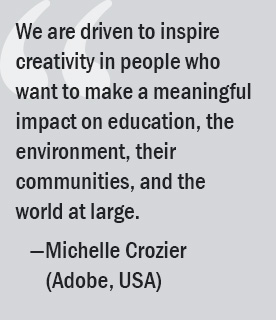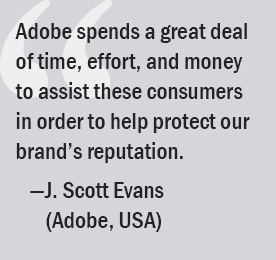Member Spotlight: Adobe Inc. Focuses Corporate Social Responsibility Efforts on Education, Environment, and Community
Published: January 15, 2020
Ken Taylor Com Laude Chicago, Illinois, USA
INTA recently spoke with Michelle Crozier, Director of Brand Purpose at Adobe Inc. in Mountain View, California, USA, and J. Scott Evans, Adobe’s Director of IP & Advertising regarding several of Adobe’s key corporate social responsibility (CSR) projects.
Ms. Crozier noted, “We are driven to inspire creativity in people who want to make a meaningful impact on education, the environment, their communities, and the world at large.” Here, Ms. Crozier and Mr. Evans outline Adobe’s CSR activities and explain how they align with the the company’s intellectual property (IP) work.
Education
Adobe is proud to play a role in preparing young people for the future by nurturing creativity and supporting creators. The company’s stance is that “creative literacy” will be a key skill in the future, and that art, creativity, and technology must be central in education. Further, the company holds that all students should have access to these opportunities, regardless of their background or circumstances. The company also runs several other programs that support the development of digital and creative skills for youth.The Adobe Digital Academy is a modern apprenticeship program that provides an alternative and accelerated pathway into the tech industry for career-switchers from diverse backgrounds.
Environment
One of Adobe’s aims is to minimize its impact on the environment. A statistic highlighted in the company’s CSR report for 2018 shows that, while Adobe’s revenue grew by 24 percent and its workforce grew by 19 percent, Adobe reduced its carbon emissions by 25 percent per employee. By decoupling emissions from business growth, Abobe has grown its business while using fewer resources to accomplish it.
Adobe is committed to running its business and operations sustainably, which includes operational excellence, addressing renewable energy as a business imperative, embracing a culture of sustainability, making a global impact by starting with communities, and achieving more through collaboration. The company is also committed to enabling customers to reach their own sustainability goals.
Adobe has set a goal to run on 100 percent renewable energy by 2035, and most recently announced an expansion of its global headquarters in San Jose, California, USA, with a new building running fully on clean, renewable energy-one of the first of its kind in Silicon Valley.
Community
Adobe asserts that innovation doesn’t apply only to software. The company invests in its employees’ and partners’ best ideas for solving social problems and creating positive change.
Through the Adobe Pro Bono Residency Program, employees lend their design, marketing, technology, and other expertise to nonprofit clients to address critical social issues, while developing their expertise and leadership skills in a new environment.
The Adobe Employee Community Fund is an employee-driven grantmaking program that supports organizations addressing challenges in the communities where Adobe employees live and work. Each year, employees vote on the most pressing social and environmental issues in their communities to determine grant selections.
With its Matching Grants Program, Adobe supports the causes employees care about. Whether employees choose to support charitable organizations through volunteer service or donations, Adobe doubles the impact of its generosity by matching all full-time employees’ donations of cash, securities, or time, up to $10,000 per calendar year.
Trademarks and Anticounterfeiting
In conversation with Mr. Evans, he explained that the Adobe trademark team works with the CSR team and marketing colleagues to brand and name various CSR efforts. “While many times the terms are merely descriptive,” he said, “we do full trademark searches for defensive purposes. In many countries where English is a second language, terms that may be considered ‘merely descriptive’ in English are registerable.” He adds that since Adobe is a global company and CSR efforts are worldwide, Adobe is careful not to launch a program that might run into trademark issues.
 Mr. Evans noted that in most countries, Adobe, like many other trademark owners, “plays a continuing game of Whack-A-Mole.” He added that these repetitive efforts are sometimes frustrating, especially in the software arena, because many consumers are taken in by the illegal sale of Adobe software. “When a duped consumer tries to activate the software program, they often learn of the deception and are very angry,” he said.
Mr. Evans noted that in most countries, Adobe, like many other trademark owners, “plays a continuing game of Whack-A-Mole.” He added that these repetitive efforts are sometimes frustrating, especially in the software arena, because many consumers are taken in by the illegal sale of Adobe software. “When a duped consumer tries to activate the software program, they often learn of the deception and are very angry,” he said.
“Adobe spends a great deal of time, effort, and money to assist these consumers in order to help protect our brand’s reputation,” Mr. Evans said. “In many ways, counterfeit sales of products can be a blight on the Adobe brand and could distract from all the good the company is doing in the world at large.”
Mr. Evans pointed out that Adobe works hard to identify the victims of software pirates and offers to assist them in becoming legal users of its software. “Adobe also spends a considerable amount of time and resources to proactively root out and shut down potential software pirates from online marketplaces and, when necessary, brings copyright and trademark infringement cases to cease the infringing activities that may harm its consumers.”
Although every effort has been made to verify the accuracy of items in the INTA Bulletin, readers are urged to check independently on matters of specific concern or interest.
© 2020 International Trademark Association
This website uses cookies so that we can provide you with the best user experience possible. Cookie information is stored in your browser and performs functions such as recognising you when you return to our website and helping our team to understand which sections of the website you find most interesting and useful.
To find out more please see our Cookies Policy and Privacy Policy.
These cookies are used to identify a user’s browser as the visitor goes from page to page on the Site. These are session cookies, which means that the cookie is deleted when you leave the Site. It is an integral piece of the Site software and used to let the server know which users are on the Site at any given time and make certain parts of the Site easier to use.
|
|
If you disable this cookie, we will not be able to save your preferences. This means that every time you visit this website you will need to enable or disable cookies again.
These cookies are used to collect information about how visitors use our Site. The cookies collect information in anonymous form, including the numbers of visitors to the Site, where visitors have come to the Site from, the pages they visited and how they have interacted with tools on the Site like search and embedded media players. We use the information to compile statistical reports of our users’ browsing patterns so that we can improve the Site.
|
|
Please enable Functionality Cookies first so that we can save your preferences!
These cookies are used to deliver advertising relevant to the interests of visitors to our Site. They are persistent, which means they will remain on your device after you leave the Site.
- Facebook (Ad Pixel)
- Google (Ad Pixel)
- LinkedIn (Ad Pixel)
- Quattro Anonymous
Please enable Functionality Cookies first so that we can save your preferences!
